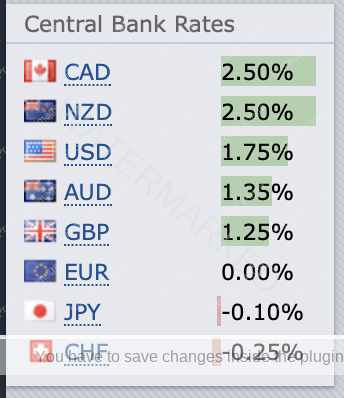Before the Global Financial Crisis (GFC) in 2008, Carry Trades (buying and holding a currency pair for the interest differential) were very popular with traders because they provided an income stream (often quite a generous stream!) with very little risk IF done correctly at the RIGHT TIME. Of course, global interest rates were a lot higher back then! In the decade and a half since the GFC, interest rates have been close to zero, but (as I’m sure you’re now aware!) interest rates are now on the rise once more. With rising interest rates, Carry Trade opportunities will start to return, so it is worthwhile learning this technique if you are not already familiar with it.
Firstly, why do traders like Carry Trades? Because for every single day you are in a Carry Trade, you receive interest. In other words, you get paid. If you are skilled at identifying turning points in the market (as taught in our powerful, three step process in the Active Trader Program Online Training), you could enter a Carry Trade and within a day or two, move your stop loss to a point of breakeven, which means you can no longer lose on the trade. Then, you can simply sit back and enjoy two very favourable outcomes. You will receive an interest payment for every day that you are in the trade, and a profit if the market moves in your favour.
As an example, you could control a $1,000,000 position size with around $33,333 of margin. If the interest rate differential is just 1% in your favour, you would receive interest at 1% on $1,000,000 on a daily basis, which would work out at around $27 per day until you close the trade. Now $27 per day doesn’t sound like much, but it’s $9,855 per annum, and based on the $33,333 margin that you put up, it works out at a 29.56% return. And that’s just the interest component! Remember, you also get the benefit of any price moves in your favour.
So how do you set something like this up? It’s a five step process that might take you a bit longer the first time, but is very quick once you know what you’re doing. In fact, if you’re already trading, it’s just a matter of choosing the right currency pair and the right trading opportunity. The secret is to treat a Carry Trade like any other trade, but to look for a longer term position in a higher yielding currency pair. Let’s explore the five steps.
Step 1 – Finding a currency pair with an interest rate differential of 1% or more
If you’re unfamiliar with currency trading, I’d encourage you to check out our free FX Trading Course on the Safety in the Market YouTube channel, which you can watch by clicking on this link here: FX Trading Course.
The best place to find the current interest rates for the different currency pairs is by going to www.forexfactory.com/calendar and scrolling to the bottom of the page until you see this table:

These interest rates were current as of 4pm on 21 July, 2022.
Choose currency pairs where the interest rate of the first currency is AT LEAST 1% higher than the second currency. For example, the NZD interest rate of 2.50% is 1.15% higher than the AUD interest rate. So we could analyze the NZD/AUD currency pair, and look for long trades (trades that make money when the New Zealand Dollar rises in value). If you were trading the AUD/NZD pair (the exact same pair, but in reverse) you would look for short trades (trades where the AUD is going down against the NZD).
Again, if you are unfamiliar with currency trading, I’d encourage you to check out our FX Trading Series.
Step 2 – Identifying a strong turning point
The key to the best Carry Trades (the ones that make the most money, and get to Breakeven the fastest) is being able to identify turning points in the market. We look for bottoms if we are trying to buy (a long trade) and we look for tops if we are trying to sell (a short trade).
The best method I know of for identifying tops or bottoms in the market is taught in the ‘Find the Turning Points’ section of Safety in the Market’s Active Trader Program Online Training. If you’ve ever wanted to identify market turning points before they occur, it is the best course I know for doing this.
Step 3 – Entering as close to the turning point as you can
Once you have identified a potential turning point in a high yielding currency, you have the potential for a terrific Carry Trade. But you still need to enter the trade. As a rule, the closer that you can enter to the turning point, the larger your position size. The larger your position size, the larger the interest payments are going to be.
There are three elements to getting in to a trade early – your swing trading abilities, the size of the swing range at the turn, and a bit of luck. Skillful swing traders have mastered the ability to follow swing charts on multiple time frames. Once a turning point is clearly identified, they simply drop down to a lower time frame and execute a mechanical entry. Since all swings in the market begin when the high or low of the previous bar is taken out, the smaller the size of that bar, the closer you can enter to the turn. And of course, sometimes you’ll need a little bit of luck, so that your turn doesn’t come in at 3am while you’re asleep!
This style of trading using swing charts across multiple time frames is part of my Wheels Within Wheels approach and is taught in the Active Trader Program.
Step 4 – Move stop loss to breakeven
This fourth step can be a little bit tricky, but essentially, once the trade has moved far enough in your direction, you can move your stop loss up to a point of breakeven. This means that IF you are wrong and the market goes against you, you won’t lose any money on the trade. You’ll simply exit the trade at the price you got in at.
This is another step that takes some skill and experience, because markets are going to fluctuate all the time. In most cases, you can’t simply buy a position and then move to Breakeven immediately, otherwise you’ll find yourself being stopped in and out of the market all day.
The trick is to think in terms of ‘Point of No Return’. Wait for the market to move in your favour, and then look to place your Breakeven stop loss at a point in the market that would indicate the trade is likely to fail if that point is touched. This will keep you safe, and also give you a better chance of staying in the trade long enough to bank those big fat interest payments!
Step 5 – Exit at Profit Target or when Stop Loss is hit
Technically, this last step isn’t as important. Some traders will simply be happy to hold their position and keep receiving interest payments for months, if not years. However, keep in mind that as awesome as it is to receive interest payments daily, by far the greatest amount of profit (or loss) on a currency trade will come from the movement of the currency. So, applying the same techniques that you used to identify the top or bottom to enter the trade, you would apply those same techniques to try and identify a profit target on the trade. In most cases, taking a profit once the market has made a strong run is going to net you more money than all of the interest on the Carry Trade, so it’s still important.
Now, those are the five steps. When you think about it, if there is more money to be made from the currency movement than the interest payments, why bother? For me, it was always about the psychology of the trade. It FEELS good to be in a trade that is paying you money each day. It’s as simple as that.
Now, what if you enter a Carry Trade only to see the market move against you? In that case, you would take a loss and move on to the next trade. At Safety in the Market, we always trade with Safety. When we are wrong, we aim to lose 1 unit of risk. If we risk $100 per trade and we are wrong, we lose $100. $100 is our ‘unit of risk’. If we are right, we aim to bank AT LEAST a 10 to 1 Reward to Risk Ratio, so if we risk $100, we aim to make $1,000 or more.
To learn more about FX Trading, check out our free FX Trading Course on YouTube.
To learn more about identifying market tops and bottoms and trading these turning points using a powerful, one page trading plan, click here to learn more about Safety in the Market’s Active Trader Program.
